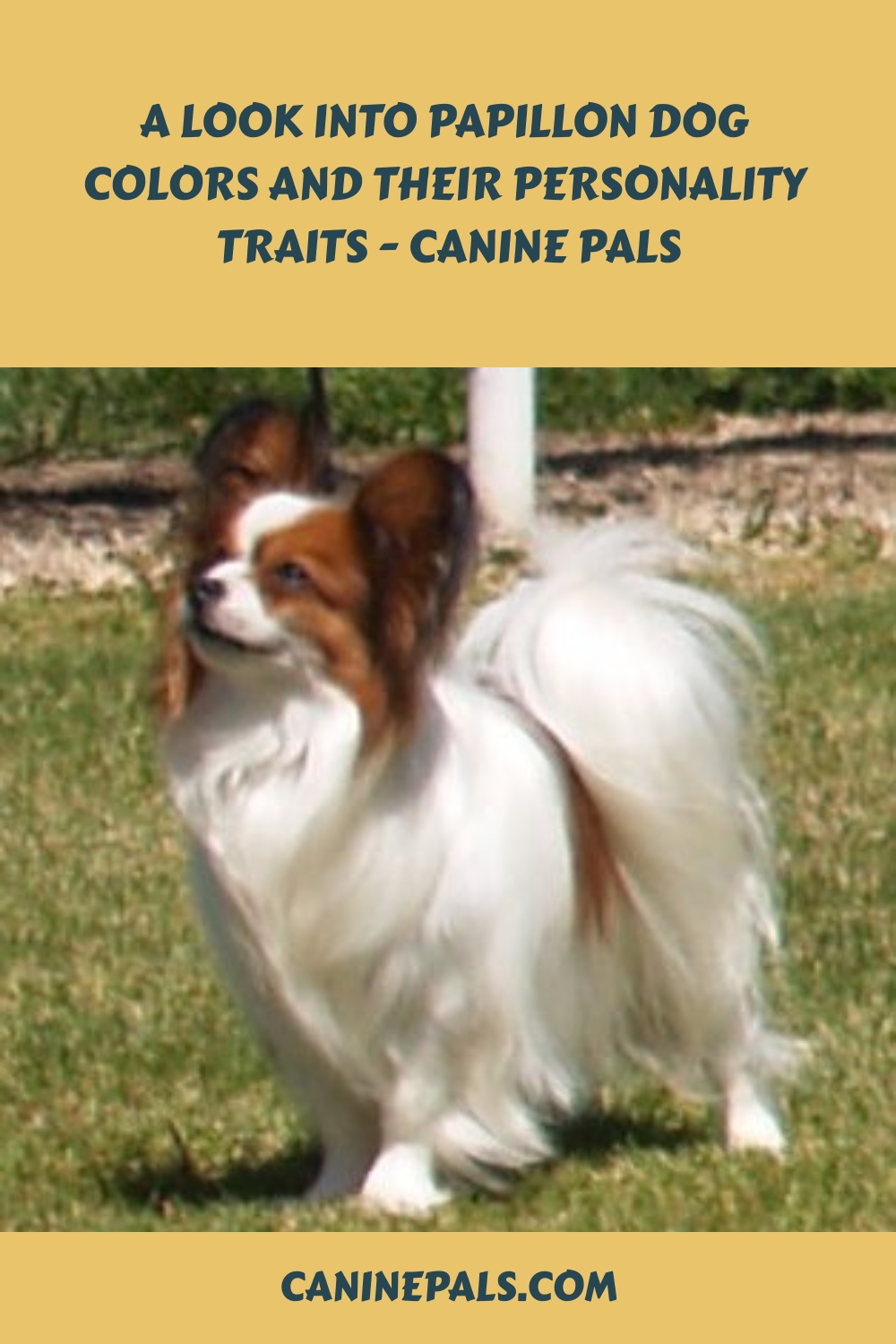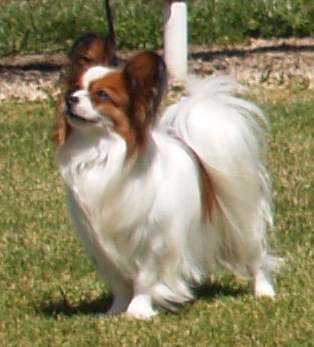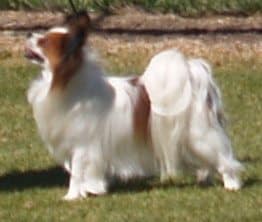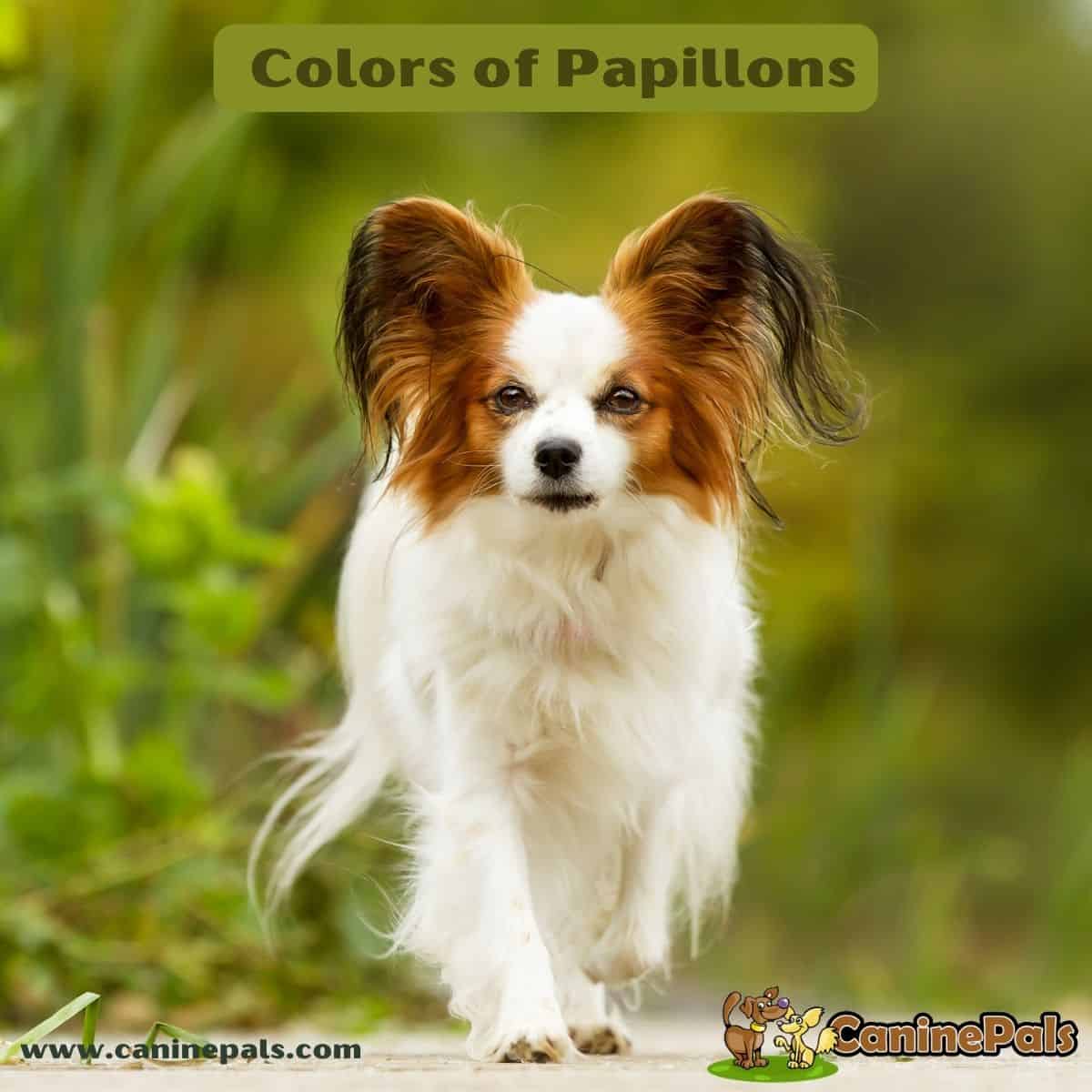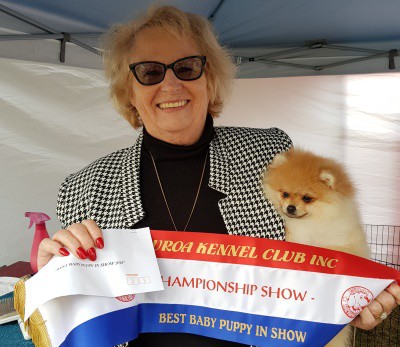Last Updated on March 20, 2024 by Denise Leo. Post first published on January 7, 2024.
The journey of life is sweeter when traveling with a Papillon.
Find the most amazing facts about Papillon dogs’. They are sweet and lovely and have mastered the skills to cheer up anyone’s mood with their jovial personality. Grouped in a toy-like breed, Papillon is a small-sized dog with long, silky hair. They are intelligent dogs able to learn quickly and have excellent memory power.
Please keep your eyes on the screen for a few more minutes and grab everything about these beautiful puppies, from Papillon dog colors and markings to their personality traits. I can’t stop admiring their enchanting colors, noticeable facial markings, and amazing traits. They are an all-in-one package that encouraged me to scribble this complete information.
AKC Recognized Papillon Dog Colors
|
From the AKC Papillon Breed Standard
COLOR – Always parti-color, white with patches of any color. On the head color other than white must cover both ears, back and front, and extend without interruption from the ears over both eyes. A clearly defined white blaze and noseband are preferred to a solidly marked head. Symmetry of facial markings is desirable. The size, shape, placement or absence of patches on the body are without importance. Papillons maybe any parti-color, provided nose, eye rims and lips are well-pigmented black. Among the colors there is no preference.
The following faults shall be severely penalized. (1) Nose not black. (2) Color other than white not covering both ears, back and front, or not extending from the ears over both eyes. A slight extension of the white collar onto the base of the ears or a few white hairs interspersed among the color, shall not be penalized provid- ed the butterfly appearance is not sacrificed.
Disqualification – An all white dog or a dog with no white.
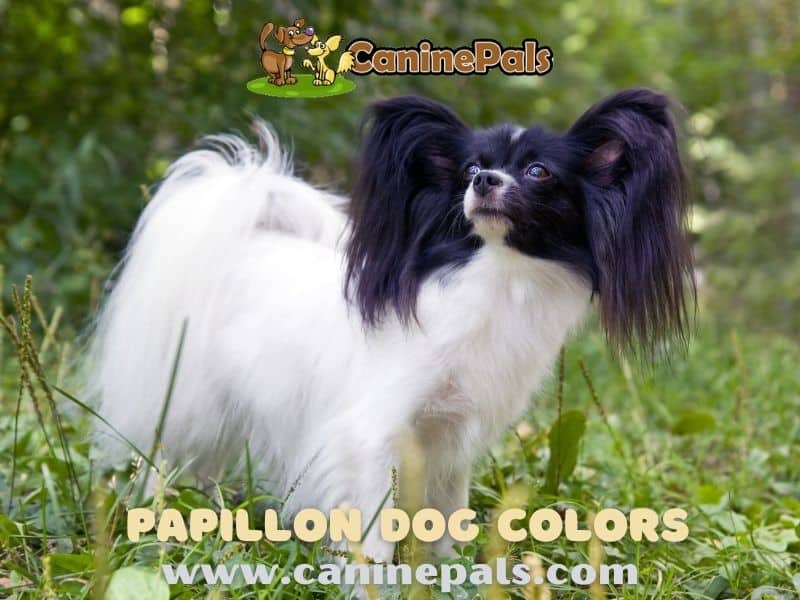
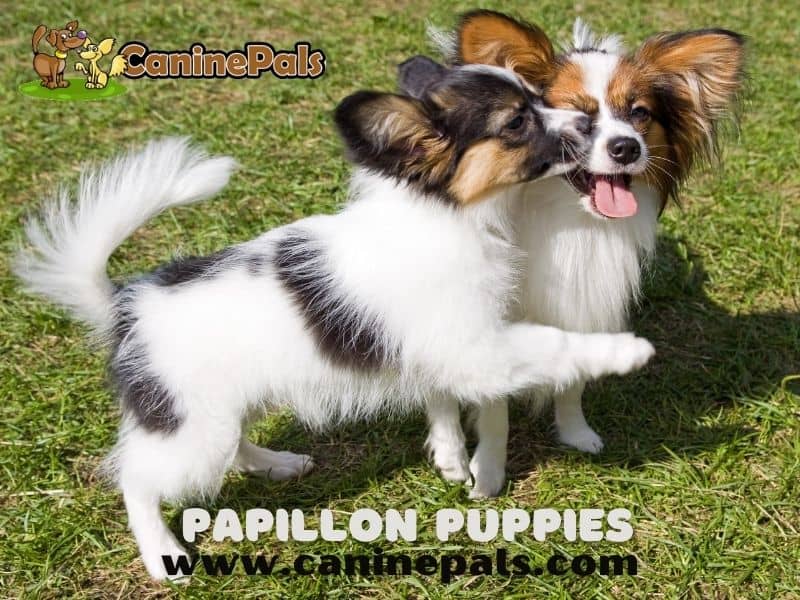
What Colors Do Papillons Come In?
The Papillon coat can be seen in multiple colors you can think of. From a black & white Papillon to red, tan, fawn, silver, and more.
The American Kennel Club standard Papillon markings are discussed below;
Black and White Papillon
The White and Black Papillon is acknowledged by the American Kennel Club (AKC) as one of the five standard colors for this breed.The Papillon’s coat is primarily white in this coloration, accented with distinctive black patches. These black patches’ size, shape, and distribution can differ significantly. They are typically found on the dog’s ears, head, and back.
Some White and Black Papillons feature extensive solid black areas covering a large part of their body, while others have smaller, more scattered black patches spread across their coat.
White and Lemon Papillon
The White and Lemon Papillon is a distinct variation within the Papillon dog breed. Unlike the more prevalent white and black or white and red Papillons, this variant features a coat combining white with lemon, a desirable attribute among Papillon aficionados. The American Kennel Club (AKC) officially acknowledges this color combination as standard. In White and Lemon Papillons, the lemon aspect manifests as a soft, creamy yellow hue. The intensity of this yellow shade can vary, depending on the specific dog.
White and Red Papillon
The White and Red Papillon features a remarkably attractive coat, primarily white, with vibrant red or chestnut accents, recognized as one of the Papillon breed’s standard colorations. These red or chestnut hues typically manifest as spots or patches on the ears, back, and tail. The shade of red in these Papillons varies in intensity. Some dogs display a bright, vivid red, while others possess a gentler, more subdued red tone.
White and Sable
The White and Sable Papillon, a variety recognized by major kennel clubs as a standard color, showcases a range from light to deep, dark brown in its coat. This sable coloring is characterized by black tipping, which adds to their appeal. The shades and patterns of sable can vary significantly among individual dogs.
With its diverse sable patterns and black-tipped fur, this particular coloration of Papillons is highly coveted by dog enthusiasts globally.
White, Black, and Tan
The White, Black, and Tan Papillon is the sole tri-color coat variation acknowledged by the American Kennel Club (AKC).
The black and tan patches are typically well-defined and symmetrical in this distinctive color pattern. The black usually marks the ears and face, while the tan adorns the legs and back, often in shades ranging from a lighter brown to cream.
However, the distribution and intensity of these colors can vary. In some White, Black, and Tan Papillons, the black and tan patches may appear more muted, with the tan presenting as a softer, lighter hue.
Non-Standard Papillon Dog Colors
Black, Brown & White
The Black, Brown, and White color combination in Papillons is not recognized as a standard color variation by the American Kennel Club (AKC).
This tri-colored Papillon showcases distinct patches of black and brown set against a primarily white coat. The black and brown patches are meant to be well-defined and separate without blending into each other. Typically, the brown patches are located on the cheeks, above the eyes, and legs, creating a specific pattern unique to this coloration.
Black, Red & White
Papillons with Black, Red, and White coloration feature black patches prominently displayed on the face, ears, and body.
Contrastingly, the red patches are ideally situated on the cheeks, above the eyes, and on the legs, lending a warm and vivid hue to the coat.
In this variation, white remains the predominant color of the coat, with the black and red patches serving as accents to enhance the white areas, creating a harmonious and visually striking color balance.
Brown & White
The Brown and White Papillon features a striking contrast between its solid brown patches and a vivid white coat, accentuating the breed’s signature butterfly-shaped ears.
This color pattern is greatly valued among Papillon enthusiasts. Breeders are particularly dedicated to cultivating this variation, producing dogs that exhibit these vibrant and consistent coat colors and maintain overall health and breed standards. This dedication ensures the continuation of this distinctive and admired color scheme in the Papillon breed.
Fawn & White
Fawn and White Papillons are marked by a blend of fawn—a light, yellowish-tan hue—and white patterns. This fawn coloration arises from a genetic alteration of eumelanin, the standard black pigment, leading to diverse color shades.
The intensity of the fawn shade can span from a pale beige to a richer tan, influenced by the degree of pigment alteration. On Fawn and White Papillons, the extent of the markings varies, ranging from minimal patches to extensive areas covering a large part of their body.
Red
A solid Red Papillon is characterized by its lush, deep red coat, devoid of white markings. This uniform coloration can sometimes obscure the breed’s distinctive features, necessitating extra attention for breed identification. Additionally, the lack of white fur means these Papillons may need more care to guard against sunburn and skin irritation.
Although the solid red coat is not classified as a standard color in Papillons, these dogs still exude elegance and sophistication, thanks to their rich, dense fur.
Red, White & Sable
Distinguishing a Red, White, and Sable Papillon demands scrutiny of its coat, as it can be easily confused with either a White and Red or a White and Sable Papillon.
The red areas on this variety can vary from a vivid, striking red to a more intense, darker shade. Meanwhile, the sable patches are characterized by a blend of black and brown hairs, creating a reddish-brown appearance. This nuanced color combination requires attentive observation to identify the breed’s specific color pattern accurately.
Sable
Sable coloring in dogs is characterized by black-tipped hairs intermingled with shades like grey, tan, gold, or silver.
The foundational coat color spans from a light sandy or creamy hue to a deep, rich red or mahogany in Sable Papillons. Typically, the fur along the back is darker than that on the belly, lending a shaded look to the coat.
The sable coat on a Papillon is not monochromatic; it often features black tips that stand out in contrast to the lighter base color, adding to the coat’s distinct and varied appearance.
White
The White Papillon’s coat arises from an absence of pigment in the fur, leading to a total lack of any other color or pattern.
This unique coat color results from a genetic mutation affecting a regulatory gene. This gene influences the formation of melanocytes, the cells that generate pigment, which colors the hair.
A notable health issue linked with White Papillons is deafness. Research indicates that dogs with white coats are at a higher risk of deafness than those with pigmented coats, a consideration important for the health management of these dogs.
White & Liver
The White and Liver-colored Papillon stands out with its distinctive color scheme, differentiating it from other breeds.
This variant of the Papillon boasts a prominent white “butterfly” pattern on its face and ears, complemented by liver-colored patches on the body. The liver color is a result of the D-locus gene, which dilutes the black pigment in dogs, producing a liver or brown shade in the Papillon’s coat.
Depending on the degree of pigment dilution, the liver color can vary from a soft, pale brown to a deeper, more intense tone, adding to the uniqueness of each individual dog within this color variation.
White & Silver
A White and Silver Papillon features a mainly white coat, complemented by silver or gray patches on its body and ears. In this coloration, the white portions of the skin usually cover a larger area than silver or gray patches.
The silver hue varies from a pale, silvery-white to a deeper, more subdued gray. These silver or gray patches are commonly found on the Papillon’s back, ears, and tail, contrasting the predominantly white coat.
Papillon Markings
Papillons are a parti-color dog, meaning they are white with patches of the colored coat. Eye rims must be black.
Facial markings are very important. Papillon markings should include a clearly defined white blaze. A clearly defined blaze is preferred over a solidly marked head. A solidly marked head will detract from an often otherwise good dog in the show ring. A clearly defined blaze adds to this breed’s butterfly appearance’. A few white hairs interspersed with the color patches are not penalized in the show ring by most Kennel Clubs.
The Rarest Color of Papillon
The color of the Papillon is the subject of discussion in almost every era. Among the standard colors of the AKC sets, the rarest Papillon colors are white and lemon.
The coat color appears pure white during the adolescent age. The white color darkens with time and changes to pale lemon, covering ears from front to back.
The color distinguishes the puppies from their own breed, making them cute and adorable.
The Common Papillon Coat Colors
With unique patches and markings, no Pap can be the same as the other. However, the common Papillon coat colors include;
- White and black
- White, black, and tan
- White and sable
- White and red
- Black-brown and white
- Black, red and white
- Sable
- Brown and white
Every Papillon is different from the others; thus, the markings and coat colors are not arranged in a specified way.
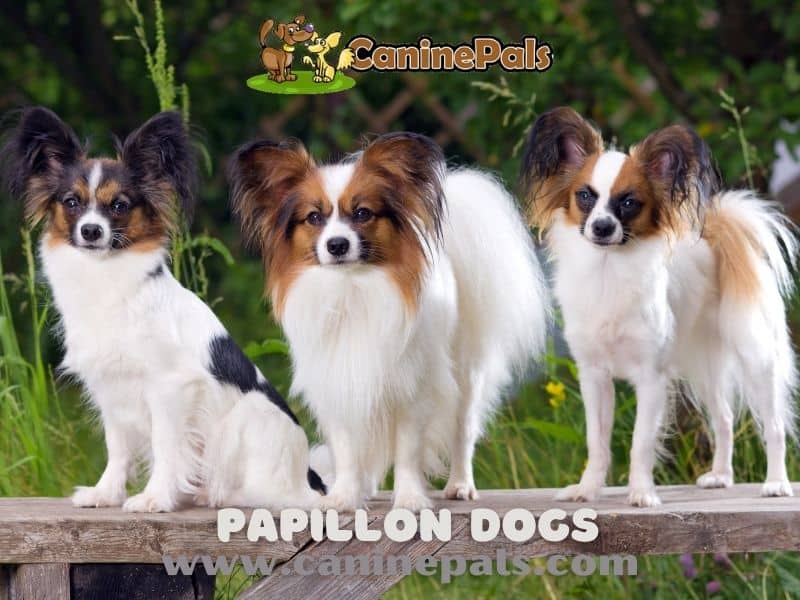
Does the Papillon Color Change Overtime?
Papillons may and may not change coat colors as they grow.
Isn’t this quite confusing? Let’s dive into details to get a clearer perspective.
Like humans, dogs are born with predetermined colors dominated by their genes. These genetic colors never change in their lifetime.
Papillons born white and red in coat color never change in their lifetime. However, their grown-up looks and appearance might differ from the infant ones as their hair extends to the fullest.
For instance, the pure white Paps’ coat color may change to pale lemon or red markings as they age. Similarly, the white and black paps change their color to sable as they grow.
As the Papillon pups’ hair becomes longer and thicker, their coat color becomes more vibrant.
About the Papillon Dog
Papillon was originally bred in France. They have a butterfly-like appearance characterized by their large ears and facial markings. These dogs are often called butterfly dogs. They are often seen as companion dogs because they are very social and often live with other animals, including cats.
The Papillon was known as a Dwarf Spaniel in the 16th and 17th centuries and often appeared in paintings on the laps of Spanish and French noblewomen. His ears used to droop, but over a period of time, an erect type started to develop. The butterfly ears are large and fringed with long silky hair, like butterfly wings. (Papillon is French for butterfly.) In the US, the drop-eared (Phalenes) and erect-eared (Papillon) dogs were born in one litter and shown as a single breed.
He’s a small, happy dog with a fine bone structure. He’s energetic yet dainty, and his ears make him stand out from all other breeds. He’s alert but neither aggressive nor shy. He plays well inside and outside. He doesn’t have an undercoat, so he only needs occasional brushing. His coat’s color should always be part colored, i.e., white with patches that can be any color. His height is 8 – 11 inches.
The Papillon is a small, fine-boned dog weighing between 6 and 10 pounds. Its head is slightly round between the ears with a well-defined stop. The muzzle and eyes are dark, medium-sized, round, and have black rims. Long, fringed hair covers the ears, giving them a butterfly-like appearance.
Papillon dog colors come in various alluring colors, making their appearance more dramatic and enchanting. The colors range from white to sable, white & chocolate, black & white, fawn & white, red & white, and lemon & white.
These adorable pups never fail to make a magnetic appearance with their wonderful colors and markings.
Damn! I admire their enchanting colors, noticeable features, and amazing traits. They are an all-in-one package that encouraged me to scribble this complete information.
Please keep your eyes on the screen for a few more minutes and grab everything about these beautiful puppies, from Papillon dog colors and markings to their personality traits.
Papillon Dogs Personality Traits
Undoubtedly, Papillons have the most amazing and phenomenal personalities. This toy breed is friendly, loving, and energetic. However, like every other dog, Papillons can become aggressive when not given proper training or are ignored.
Below is everything about Pap’s personality traits and how they make a good pet dog.
1. Unbeatable Smartness
Papillons are as smart as a whip. Dogs of this breed are intelligent and respond well to positive reinforcement training methods.
Paps is ranked as one of the smartest dog breeds, highly intelligent, alert, attentive, intuitive, and eager to please their owners.
P.S. Want to check their smartness? Teach them a trick!
2. Papillons are Friendly
If you have a Papillon puppy in your home, forget all the boredom, loneliness, and gloominess.
Papillons are small and fluffy. Their friendly nature makes them the best pet dogs. Their playful nature never lets you get bored; instead, they often come to their owner, whirl around them, lick them, and say HELLO!
The jovial personality dogs will often accompany you for walks and enjoy the outdoors. They are good for people living in an apartment because they do not need much space to run around.
Moreover, they are friendly enough to get along with kids and pets easily.
3. Packed in an Energized Soul
Despite their small size, these butterfly-like dogs are known for their high energy.
You will never see Paps sitting on the couch enjoying the T.V. shows. They love doing ordinary stuff that involves physical activities and playing hide and seek.
Their physically active lifestyle keeps them healthy and jolly.
4. A Watchful Dog
With Papillons, say goodbye to housebreaking!
Papillons are home-friendly dogs that do well with families with kids. Though they are busy playing and doing multiple activities, they don’t heed their surroundings.
Papillons have a strong sense of smell and can sniff even a minor thing.
Moreover, they can be vocal depending on the mood and situation. They are vigilant enough to observe who enters the house, changes in their daily routines, and more.
Despite their small size and toy-like personality, Papillons can stand up against any danger or dog that comes their way, which helps homeowners keep the burglars at a distance.
5. Happy-go-lucky Dogs
Papillons have mastered the skills of making everyone happy with their charismatic personality.
Their happy-go-lucky personality keeps them and their owners happy and free. They work as a therapist and can transform the sad moments into the loveliest and most memorable ones.
6. Their Extrovert Nature!
Papillons are extroverts in nature – outgoing, socializing, and happy. They love to accompany their owners for a walk or shopping.
Paps are good for kids and other pets. They are talkative, enthusiastic, and action-oriented. They love to share every single detail with their owners.
Papillons love to engage with people and never dwell on problems.
7. Love Buds
Papillons are love buds. They grab their owner’s attention, value them, and make the best friends.
They show their love and affection through their body gestures by whirling around you, licking, wagging their tail, and relaxing on your lap.
These dogs always make their owner feel special and value their presence. These lovesick puppies develop an unbreakable bond with their owners and are great family pets.
If you’re looking for a dog plus a friend who never makes you feel alone, Papillons are the perfect one.
8. Loyal, Loyal, Loyal
Like other dog breeds, Papillons are a true example of loyalty. They show the real definition of love and loyalty.
9. What is Shedding?
Papillons have long, thick, and silky hair; unlike other long-haired breeds, Papillons don’t shed at all.
Their minimal shedding throughout the year doesn’t demand regular maintenance and grooming.
However, small grooming sessions must be timely, including nail trimmings, ear cleaning, and baths.
Note: Papillons are delicate and fragile, so the maintenance sessions must be concise and prudent.
10. Don’t Forget to Train Them!
Papillons are like human babies who love to poke their fingers in everything, get excited at one moment, and get sad at the other moment.
Although Paps are friendly, intelligent, alert, and happy-go-lucky, they can be subtle and aggressive. Therefore, it is recommended to train them to avoid terrible behaviors.
P.S. Papillons are intelligent and never have a tough time learning things.

Common Health Problems in Papillons
The Papillon dog breed is the healthiest dog, with a 13 to 15-year life expectancy. These dogs are popular for their butterfly-like look and low shedding coat, making them a perfect toy pet suitable for allergies.
These dogs are smaller in size and are as fragile as monkeys. This toy breed is prone to serious injuries or health issues when not taken care of.
Like every other dog breed, Papillons are also prone to common health problems. It is necessary to consider health issues before entering into a long-term relationship.
Below are the common health issues found among Papillons;
1. Dental Disease
Most people are unaware that the mouth can be the root cause of multiple diseases.
Many owners are heedless of their Pap’s dental cleanliness, which causes multiple problems. The condition can become severe over time and hampers eating and drinking habits.
Dental disease in papillons starts with tartar building up on the teeth, leading to gum disease and tooth decay.
When ignored in dogs, the dental problem can damage kidneys, liver, heart, and joints. This also reduces the pup’s lifespan. And who wants their pup’s life to be cut down? None, right?
Here are some tips to take to maintain the dental well-being of a Papillon.
- Feed your Pap a healthy and hygienic food that he enjoys
- Timely brush their teeth. It is good to clean their teeth once or twice a week. This prevents tartar and cavity formation in teeth, which is the root cause of multiple diseases.
- It is also necessary to vaccinate your dogs on time. This reduces further problems and ensures your pup stays healthy and happy.
2. Obesity
Papillons weigh between 4 to 9 pounds. These dogs are small in size and, thus, don’t require much exercise. However, when these puppies are overfed, they are suspected of gaining weight.
Obesity in puppies can result in several health issues, including cancer, arthritis, respiratory problems, and more, which shorten their life expectancy.
To ensure your pup is healthy and maintains appropriate weight, it is necessary to follow a balanced diet, avoid junk foods, not consume many sweets, and exercise regularly.
3. Parasites
Several worms and bugs can invade your furry friend’s body, inside and out. They include fleas, ticks, ear mites, and other parasites. These parasites may cause pain, discomfort, and even death.
It is recommended to consult a vet regularly to avoid future problems.
4. Allergies
In humans, an allergic response to pollen, mold, or dust can cause sneezing and eye itching.
Similarly, Papillons also respond to some things that cause allergies. Commonly, the feet, belly, and ears are most affected. Symptoms typically start between one and three years old and can worsen yearly!
Paps react to allergic reactions by licking their paws, rubbing their face, and sometimes showing aggressive behavior.
It is suggested that you consult a vet as soon as you observe pups licking and rubbing themselves.
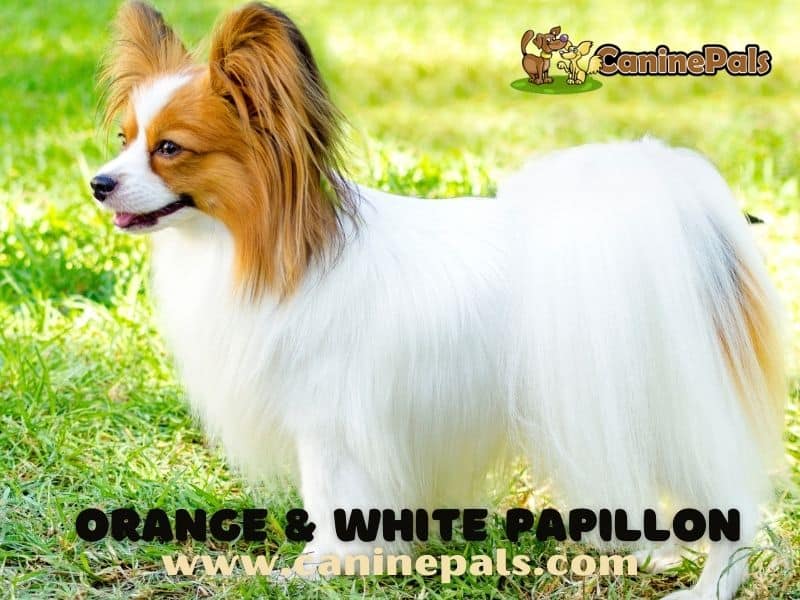
Papillon Health Issues
Besides the common health problem in almost every breed, Papillons inherit some diseases from their ancestors. These diseases cant be completely treated; however, timely vet consultation can reduce the effect to an extent.
Some of the problems inherited by Papillons are;
- Knee problems with ligament tear
- Kneecap problem
- Liver issue
- Bleeding disorder
- Heart disease
- Eye problems
- Retained puppy teeth
- Bladder or kidney stones
- Epilepsy
- Thyroid
- Deafness
- And more
Note: Though Paps can inherit several diseases from their forefathers, this doesn’t make them any less. Their charismatic personality still tops the list.

Final Words on Papillon Dog Colors
In conclusion, the Papillon, a delightful member of the toy breeds, offers a spectacular array of colors that add to the charm of these small dogs. Known for their distinctive erect ears reminiscent of a butterfly’s wings, which is where the French word ‘Papillon,’ meaning butterfly, comes from, they stand out in the continental toy spaniel category. With their long hair and expressive faces, these little dogs have captured the hearts of historical figures like Marie Antoinette and modern dog lovers.
While Papillons are often seen as lap dogs or tiny companions, prospective owners should seek responsible breeders, particularly as this breed can have health concerns like patellar luxation and open fontanel, a condition linked to their small head size. The Papillon Club of America and similar organizations in the United States emphasize the importance of health and breed standards, including various solid colors and patterns.
These toy dogs embody elegance and playfulness, whether with drop ears or the more traditional erect ears. As small breeds go, the Papillon is not just a companion but a historical icon, a living art piece with a palette of colors that range from striking solid colors to more intricate mixed patterns. Their size and appearance might categorize them as tiny dogs, but their vibrant personalities and colorful coats make them larger than life, a true embodiment of the butterfly dog.
Copyright CaninePals. All Rights Reserved.
References and Further Reading:
American Kennel Club Papillon Dog Information
